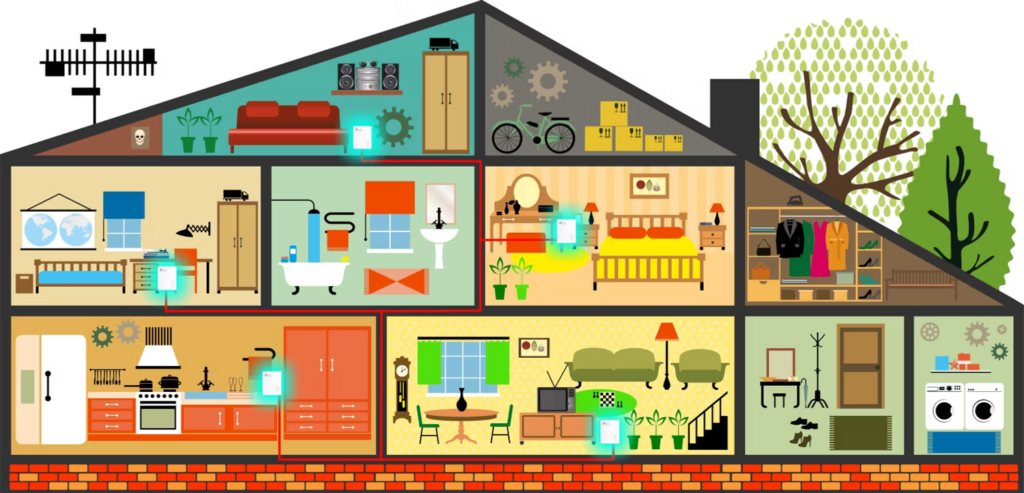The solution may be a Wi-Fi extension or Powerline Adapters if the Wi-Fi signals coming from your router are spotty and unstable.
We all experience poor Wi-Fi signal at some point or another. There are numerous potential causes and treatments, but it might be difficult to pinpoint the particular one. If none of them work, what should you do next?
There are primarily two ways to increase your Wi-Fi signal. They are not equal, though, and one is not necessarily preferable to the other. Let’s compare powerline adapters and Wi-Fi extenders to see which is the better option for you.
Understanding Wi-Fi Extenders
A Wi-Fi extender is a little wireless gadget that captures your router’s signal and distributes it again. You may extend Wi-Fi service into your garden or into previously unreachable areas of your home by placing the extender in the ideal location.
It goes without saying that they are an affordable and practical method to increase Wi-Fi coverage across your entire home, and there are a number of reasons to prefer them.
There are two types of Wi-Fi extenders: compact desktop devices and wall plugs. Typically, connecting the device to your network only requires inputting your standard Wi-Fi password during setup.
Finding the optimum location to provide the best coverage and speed is therefore necessary, just like with the router itself. Contrary to what you would have thought, this might be a little nearer the router.
Keep in mind that the signal quality that the extender can rebroadcast is limited by the signal quality that it receives. The extender will only be able to re-broadcast the same weak and unstable signal if it is placed directly at the edge of your router’s coverage area.
Positioning a Wi-Fi Extender
The majority of manufacturers advise setting the extender so that it is approximately halfway between the router and the region you want to cover.
In a perfect world, there would be no major physical impediments (such huge walls) in either direction or line-of-sight to both places. These obstacles might impair the wireless signal’s power.
However, Wi-Fi extenders are not flawless. No matter whatever Wi-Fi extender brand or model you employ, some signal loss will inevitably occur. It’s just a fact of modern technology. In order to communicate with your Wi-Fi router and receive the Wi-Fi signal, all Wi-Fi extenders divide the bandwidth they have available into broadcasting to other devices and receiving the Wi-Fi signal.
By choosing a dual-band Wi-Fi extender over an older single-band one, you may reduce Wi-Fi extender signal loss. The dual-band Wi-Fi extender will increase both the 2.4GHz and 5GHz signals, the latter of which having a greater range but a slower connection speed (which has a smaller range but faster connection speed). All of your Wi-Fi-enabled devices will have a higher chance of obtaining a reliable Wi-Fi connection if you boost both.
Positioning a Wi-Fi Extender cont’d
Additionally, you may choose one band of some Wi-Fi extenders for communication with your network and another band for communication with your devices. For instance, the BoostBand technology from Amped Wireless
“Will make use of the 5GHz channel between the Router and the Range Extender. It will use the 2.4GHz connection with the Router if the 5GHz connection is not available or is too weak. Both 2.4GHz and 5GHz devices will still be able to connect to the Range Extender when BoostBand is enable. But communication between the Extender and Router will only use one band.”
While it’s not against the rules to mix and match manufacturers, a Wi-Fi extender must have a speed that matches that of the router it’s linked to. Because Wi-Fi standards are backward compatible. If required, you may utilize an 802.11ac extender at maximum speed with an older 802.11n router. You cannot use an N-rated extender with an AC-rated or AX-rated router; doing so would significantly reduce performance. A fantastic option to increase the range of your Wi-Fi without spending money on new gear is to repurpose an older-than-new router.
Even better Mesh Networks
Although a Wi-Fi extender is a quick and easy solution to enhance your Wi-Fi range, it could still be slower than simply connecting a device to your network. Dead spots could still be present.
Future systems may do away with the requirement for extenders by utilizing a mesh Wi-Fi network.
To give complete wireless coverage, mesh Wi-Fi systems feature one device linked to your modem and several more devices scattered around your home. Mesh Wi-Fi generates a single seamless network as opposed to extenders, which each produce a unique network with their own SSID (i.e., network name).
Additionally, they may be quicker and more effective. Data may be dynamically redirect across all of the devices on the network instead of flowing in a linear way as it would on a typical network because each unit has two radios (one for receiving data and one for disseminating data).
Understanding Powerline Adapters
By sending data via your home’s electrical wiring, a powerline adaptor network lets you overcome subpar Wi-Fi performance. Powerline adapters, which are tiny wall plug-size devices with Ethernet connections, are use to power it (and, in many cases, Wi-Fi functionality).
In other words, powerline adapters convert the electrical outlets in your home into Ethernet ports.
You attach one adapter to your router and plug it into an adjacent electrical outlet to set it up. You then insert a different adapter into an outlet in a different room before connecting a device, such as your computer, to the adapter. And that’s it—in theory, at least.

Because you don’t have to worry about locating powerline adapters within range of your network or about wireless dead spots, they are preferable to Wi-Fi extenders.
But that doesn’t mean you shouldn’t be concerned. Your powerline adapters should connected to the same mains circuit for the best performance. Although the signals they convey can move between circuits, each time their strength is reduce.
Powerline Adapters cont’d
The distance should be kept as brief as feasible. With each additional mile that the signal travels, the transmission speed decreases. The standard recommendation is 200m or less, taking into account any extra wire that could be tucked away beneath your flooring. It goes beyond the shortest path between rooms.
Noise is a significant element that can negatively impact a powerline network’s performance. Unavoidable electrical noise is increased by putting the adapter into an extension cord or placing it close to another large electrical equipment. Even a small inconvenience, like flashing Christmas tree lights, can drastically slow down your internet.
Finally, powerline adapters must never be used with extension cables, power strips, surge protectors, or uninterruptible power supply. They frequently filter particular frequencies, which results in (at best) slower or nonexistent data transport (at worst).
Which Is Better for You: A Powerline Adapter or a Wi-Fi Extender?
Powerline networks and Wi-Fi extenders are both practical solutions for dealing with weak Wi-Fi signals. They are undoubtedly more practical than running lengthy Ethernet cables from room to room across your house.
For many people, a powerline adapter is definitely the wiser choice. Although they may appear more technical, they are not. For the majority of people, all you need to do is plug them in. It should just take a few minutes to set up.
Powerlines have a number of advantages. They have a longer range, so you should have no issue extending network connectivity to every area in your house.
Additionally, Wi-Fi-enabled powerline adapters are available, which combine the advantages of both Wi-Fi extenders and powerline adapters. If you desire a connected connection to a gaming console, for example, they are also simpler to utilize with Ethernet connections.
Wi-Fi extenders are another quick and simple solution. However, if you want a good dual-band device, you need pay a little more money. It is a waste of time and money to purchase a single-band, low-cost device.
Additionally, extenders don’t completely address the problem of dead areas in your home in any scenario. Although they can extend Wi-Fi’s coverage beyond the range of your router, heavy objects like thick walls or even a sizable wardrobe will still lower the speeds you can use. To get complete coverage, you’ll also need to daisy-chain several Wi-Fi extenders, which will result in signal loss at each relay.
4 More Solutions for Poor Wi-Fi Speeds
Make sure you are utilizing your current Wi-Fi network to its full potential before investing in a powerline adaptor or Wi-Fi extension.
- Boost the router. You probably stand to gain from an upgrade if your router is older than a few years. The newest 802.11ac-compliant routers are three times quicker than 802.11n routers. Your connections will be speedier and more reliable if you can use the 5GHz frequency. A new 6GHz Wi-Fi band is introduced under the most recent Wi-Fi 6E standard, providing more capacity than before.
- Refresh the firmware. Verify whether your router has any accessible firmware upgrades. These may result in better performance, including a more solid and dependable connection. Updated router firmware is simpler to install than you might imagine.
- Change the options. To make sure you’re utilizing your router at its optimum speed, look at its settings. Examine the channel settings as well to lessen interference from neighbouring Wi-Fi networks (e.g., neighbors). Your Wi-Fi speeds may increase if you switch channels.
- Verify the location. After reading our location recommendations for routers, consider where yours is presently situated. The signal strength of a router can be significantly affected by moving it just a few feet in any direction. Also, take into account whether your laptop, gaming console, or other device might be slowed down by any dense obstacles that are close by.
The Best of Both Worlds Is Possible
When it comes down to it, a Wi-Fi enabled powerline adaptor is the logical choice. They function better than a typical Wi-Fi extender, and you may choose to connect over wired Ethernet if you so want.
Frequently Asked Questions
1. Why does using an extension make my Internet worse?
The Wi-Fi signal will be weaker the further the Wi-Fi repeater is from the router. On the same frequency as a router and wireless devices, a Wi-Fi repeater connects to them. This implies that only half of the available bandwidth will used by your wireless devices. Slower connection speeds result from insufficient bandwidth.
2. Can an extension for Wi-Fi improve a shaky Internet connection?
In addition to increasing the range of your signal, Wi-Fi boosters may also increase your Internet. They contribute to increased speed by removing dead patches. Wi-Fi speed and your Wi-Fi signal are directly connected. Therefore, your Internet performance increases when your signal is strong and covers all area of your house.
Read more:
What Is HTTP/3? How Does It Compare to HTTP/2?
How to Find Your Router’s IP Address
How to Boost Your Wi-Fi Speed Up to 5x With These 2 Easy Fixes



